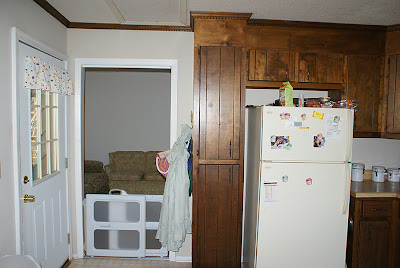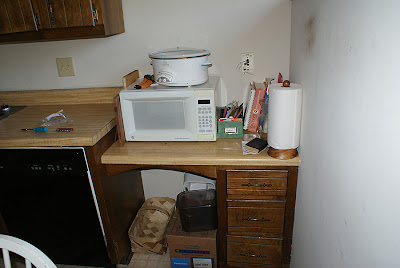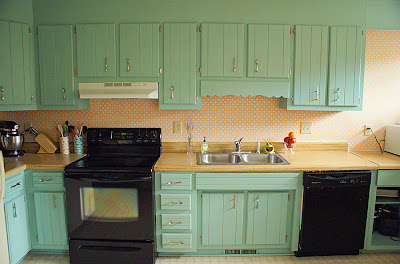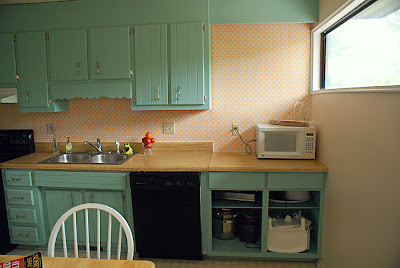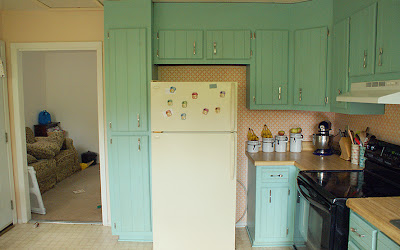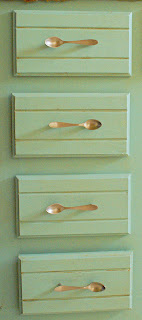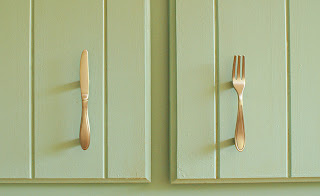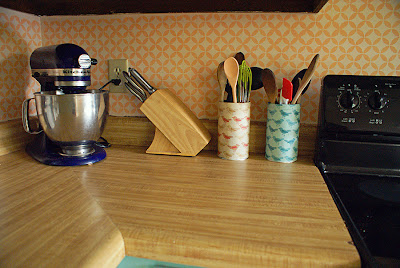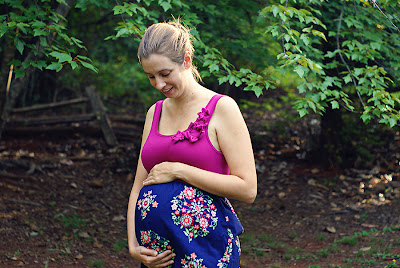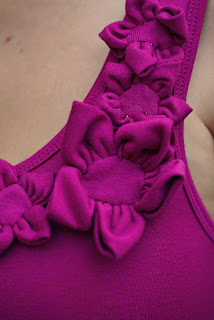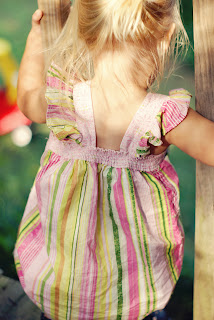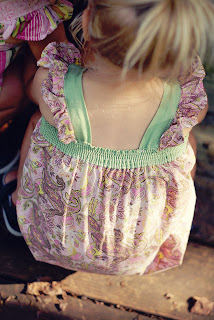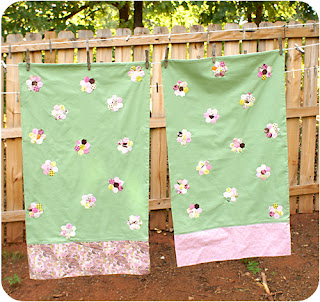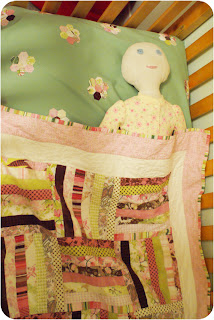05
2011My kitchen was a cave.
Dark cabinets, super old fake wood laminate counter tops, dark dental molding all the way around the room, and dirty flat painted beige walls were sucking out the light from the 4 windows in the huge room. Here’s proof:
Additionally, there was this little desk in the corner that really served me no purpose. And the final straw was that no drawer in the whole kitchen was wide enough for a silverware sorter except for one of those desk drawers.
After we ripped out the wallpaper in the master, prepared the girl’s nursery, and spontaneously redid the guest bathroom, I set my sights on the kitchen. Our budget was (is) tiny so I knew we’d have to do work in stages. For Stage 1, I wanted the most visual change for the least amount of money (especially since midway through this process we found out about our Surprise Baby!).
Can you believe that most of this change is paint?! I hardly recognize the space when I pulled out the before pictures!
Breakdown of costs:
Removal and Replacement of Desk: Free!
Derek pulled out the desk saving the fake wood counter-top. My father-in-law built the new cabinet using scrap wood and materials. The two of them attached a piece of wood to the back of the old counter top to make it as long as the rest of the counter tops and replaced it ontop of the new cabinet. Obviously it still needs doors… but right now everything down there is for the girls to play with 🙂
Primer, paint, glaze small rollers for the cabinets: approximately $60.
We used a gift card for the primer/supplies and only had to pay for the paint and glaze. All work was done ourselves.
Whimsical fork, knife, and spoon pulls for the cabinet doors: Free!
They were a Christmas Gift from my parents!
New hinges for the Cabinet Doors to match pulls: approximately $15.
It would have cost more, but a couple sets of the hinges came with the pulls at Christmas 🙂
Paint for the walls: approximately $30.
That dirty beige flat paint sucked up paint like a sponge so we actually needed two cans. However, I bartered sewing skills for the second can of paint (thanks, Jessica!) and we ended up having enough in the second can to also paint my entryway. Bonus! 🙂
Stencil, brush, and acrylic paint for the back splash: approximately $35.
The stencil (found here) cost about $29 with a coupon code from an ad on The Nester’s blog. The brush and cheap acrylics made up for the rest of the price.
Cute bird containers: Free!
The containers are actually entertaining cookie tins that we’ve had since we got married and used for the same purpose of holding spoons and such. I had Mod Podge leftover from the girl’s bird art and the fabric is from the remnants of a dress I just finished. I have some more of this bird fabric and I’m debating between putting some on the bottom of kitchen towels or making hot pads. I may have enough for both…
Total Cost: $140
Stage 2 Plans include:
- New Curtains
- Doors for the Cabinet
- Replacing the Crown Molding we tore out in the whole room (should it be cabinet color… or white?)
- A Sturdy Shelf for the Microwave between the cabinets and wall (a built-in won’t fit above the stove)
- A Storage Bench for kiddos to sit on at the dinner table
- And I’m trying to talk Derek into letting me paint and stencil the linoleum since redoing the flooring is last on our to-do list. I don’t think I’m succeeding… but I can keep trying. 😉
- Oh, and eventually all our appliances will be black… we just don’t replace until they die. Though getting a new stove hood is pretty tempting… especially knowing how cheap they are.
And just a little recap:
02
2011So I totally took step by step pictures of the entire process of making this nursing dress when I made the fabric flower tutorial…. but it appears that I somehow deleted each and every one of them before getting Derek to take pictures of the dress on me. Sigh. So you’ll have deal with very non-visual instructions on making yourself this dress. 🙁
1. Try on a tank and mark about 1″ below a good empire waistline for you. Cut the bottom of tank off. (in retrospect I might have cut it so that the back was shorter than the front since you can see how it’s longer in the back)
2. Cut a 4″ strip from the top of the remaining bottom half of the tank. Fold in half. With right sides together pin and sew to the bottom of your Empire waist-ed tank top.
3. Measure around the fullest part of your hips if you’re making this for nursing or the fullest part of your tummy if you’re expecting (or if your hips are wider than your tummy measure that). Add 6-12″ of ease (less if you’re nursing, more if you’re expecting and making this near the beginning of your pregnancy). Divide the measurement in half and add one inch.
So the formula looks like this Hip/tummy measurement + 6-12″ / 2 + 1″ = X or the width of the front and back skirt panels.
4. Now measure from the seam you made on your tank to the length you’d like the skirt to be. Add 2.5″ for the seam and hem allowances.
Formula for length: Desired length + 2.5 = Y or length of skirt panel.
5. Cut 2 skirt panels X by Y. If you do full length like I did, you may want to taper the skirt out in a trapazoid fashion so that it’s about 3-6″ wider at the bottom than the top. I can’t take too long of a stride in this dress because I didn’t do that.
6. Sew skirt front and backs together at the side seams.
7. Make a tiny hem at the top of your skirt piece.
8. Hand wind a bobbin with elastic thread. Sew two lines of stitching around the top of the dress with the elastic thread in the bobbin and high tension on the top thread. (if you’re making the dress nursing friendly, you may want to sew a couple extra lines of elastic in the front panel: especially if you’re pregnant when you make the dress).
9. Pin the skirt to bodice seam right sides together with the waistband itself turned up and out of the way. (this is the hardest step without a picture. Basically, the skirt will be inside the front of the dress with the waistband turned out of the way. Your waistband will be sandwiched between the skirt and tank. I’m probably over explaining…)
Leave most of the skirt gathers at the front and back of the dress leaving the sides straight. If you want the dress to be nursing friendly, do NOT pin the front of the skirt to the bodice. The elastic thread should hold it up. If you’re not concerned about nursing access then go ahead and pin the front down.
10. Try on the dress and adjust as necessary. Mark your hem placement and then turn up and sew your hem.
11. Embellish as desired. Enjoy your dress!
28
2011I made these Spring Ruffle Dresses about a month ago and we have been wearing them a lot! Nothing is more perfect for this age than a sundress: quick diaper changes, easy removal, and at this short length no restriction on movement. This is the very last of their quilt fabrics and bedroom fabrics (Basic Grey’s Sultry for Moda).
I used the Spring Ruffle Top tutorial on Sew Mama Sew with a couple of modifications.
First, I just used the tiny bit of fabric I had left for the skirt portion rather than measuring it and gathered it to fit the front portion in the center only.
Second, I cut the back bodice piece the same length as the back skirt piece and shirred it with elastic bobbin thread so it would grow with them and maybe be used as a top next year.
I think I also reduced all the width measurements of the bodice and strap pieces to 2 inches.
I think this is the perfect beginner clothing sewing pattern (hint hint, Jessica… I think you could totally do this for K, espeically without the shirring :-p)
14
2011I know I’ve left you in suspense for nearly 2 years on what I was going to do with the hundreds of tiny little hexagons made with leftover fabric from the girl’s quilts. I could keep the suspense going…. 😉
Or I could tell you that I just finally got around to making their pillowcases! Here they are, sprinkled with hex flowers on one side and plain on the other.



